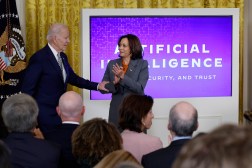OMB and GAO tangle over high-priority IT program reporting

A new Government Accountability Office report reaches some contentious conclusions about how the Office of Management and Budget evaluates high-priority information technology projects.
The congressional watchdog’s report, issued Tuesday, centers on how OMB’s Office of E-Government and Information Technology assesses the top 10 high priority IT programs across the federal government for quarterly reports to Congress.
GAO claims that the E-Gov office didn’t ensure oversight from the federal chief information officer — who is also based within OMB — and fell behind on issuing the assessments on a quarterly basis, issuing only two — in June 2015 and June 2016.
OMB says the GAO is misinterpreting some of the requirements that Congress has put on the E-Gov office.
The quarterly reports were mandated by the fiscal 2015 omnibus appropriations bill, which required OMB to detail the 10 highest-priority IT investment programs under development and their quarterly status.
E-Gov officials told the GAO that competing reporting requirements, a lack of resources and the time required to craft the reports prevented the office from being able to construct them on a quarterly basis.
GAO noted that after 2016, the E-Gov office stopped issuing the reports at all, instead deferring the action to the U.S. Digital Service due to OMB’s interpretation of the fiscal 2016 omnibus spending bill, which directed USDS to issue quarterly reports on its projects.
“However, continued identification and reporting on the top ten high priority programs, and not just USDS projects, would further enhance congressional oversight by providing congressional stakeholders with information on high priority programs that is not readily available,” the GAO report said.
“Such information could also be useful for current administration IT governance entities such as the Office of American Innovation and the American Technology Council, to assist them with prioritizing their efforts to modernize federal agency IT.”
While E-Gov staff detailed their process for communicating with agency CIOs about high-impact IT programs on a frequent basis, depending on the level of risk attached to the project, GAO noted that the office didn’t include oversight analysis from the federal CIO due to the number of projects reviewed.
However, GAO officials noted that 2010 TechStat reviews determining the validity of IT projects had included the federal CIO and resulted in $3 billion in cost savings and avoidances.
GAO offered three recommendations as a result of the report:
- That the OMB director should resume the quarterly reports detailing the top 10 high-priority IT programs, including the level of USDS involvement.
- That the federal CIO is directly involved in the oversight of the identified high-priority IT programs.
- That OMB continue quarterly, but separate, reporting of USDS projects.
GAO officials said that OMB neither agreed or disagreed with the recommendations, but instead expressed “concerns with GAO’s alternative interpretations of law and that GAO’s findings and conclusions are rooted in an incorrect legal interpretation of OMB’s annual appropriation,” claiming that the GAO assumed that reporting requirements for one appropriation period extended to all future periods as well.
But GAO asserted that the report is not a legal determination, but instead would be beneficial for congressional oversight.
OMB officials also took issue with GAO’s assertion on the involvement of the federal CIO in oversight, claiming that the accountability office had said the move resulted in inadequate oversight. GAO disputed this claim, saying that federal CIO involvement would merely improve accountability.
OMB officials also said that USDS is currently discussing whether quarterly briefings, as opposed to reports, would meet requirements, but GAO reaffirmed its reporting recommendation.






